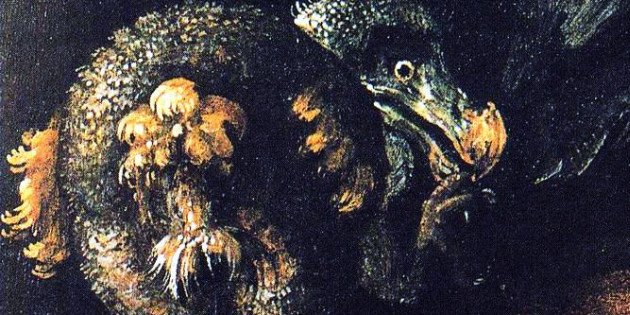
The Dodo (Raphus cucullatus) — that towering icon of modern anthropogenic extinctions — was a pigeon. Not, as Linneaus thought, an ostrich, nor even, as later scientists concluded, a distant cousin of pigeons deserving of family rank, it was an honest-to-goodness pigeon, deeply embedded within the family Columbidae. In fact, the Dodo belonged to a clade (sometimes called Raphini) of 15 remarkable, bizarre, intriguing island-adapted pigeons, some of which are still alive today, but eight of which have been hacked from the tree of life, driven to extinction by humans. The painting above is by 17th-century Flemish artist Roelant Savery.
Raphini
A 2007 genetic review of pigeons and doves (Pereira et al. 2007) found three major clades within the order Columbiformes, which are nicely laid out by John Boyd here. One of these clades holds a diversity of Old World species in several distinct groups, including an Australasian clade, the green-pigeons, the emerald- and wood-doves, the imperial-pigeons and fruit-doves (favorites of mine), and the subjects of our investigation today, the 15 known members of the Raphini.
All of the birds within Raphini are highly specialized for island life. They have colonized far-flung corners of the Indian and Pacific oceans, and when they found safe havens free of predators, they took on some truly remarkable forms.
The ancestral species that founded this tribe must have been magnificently volant, capable of crossing vast expanses of open water in search of food and safe nesting grounds. One species alive today offers a glimpse of such behavior: the Nicobar Pigeon (Caloenas nicobarica). It’s a spectacular pigeon with long neck plumes and blue, green, and copper iridescence in its feathers (I mean, look at this bird), and it lives on islands from the eastern Indian Ocean all the way out through northern Melanesia. “A ground-dwelling inhabitant of dense lowland rainforest,” notes Doughty et al.’s Birds of the Solomons, Vanuatu, and New Caledonia, “nests colonially on small offshore islands, but visits coastal lowlands of larger islands to forage for food.” Beehler et al.’s Birds of New Guinea notes that the species is often seen moving in “high-flying flocks,” and Coates and Bishop’s Bird of Wallacea declares, “this species has suffered greatly from human predation and is now generally scarce to very rare.”
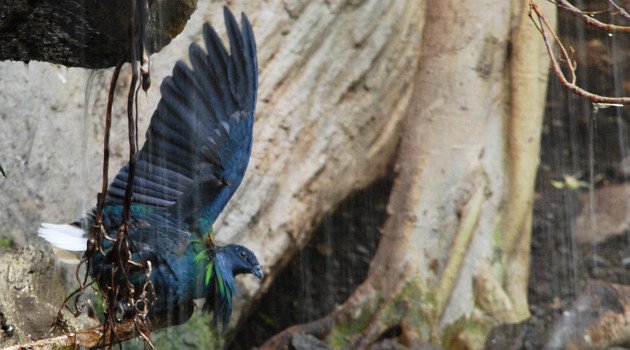
A Nicobar Pigeon bathes at the Smithsonian’s National Zoo in Washington © David J. Ringer
As the ancestral raphine pigeons found remote specks of land in the vastness of the southern oceans, they made themselves at home and — often without significant predators to challenge them — diversified in amazing ways. All the other living members of the tribe are medium-sized to large birds, frequently terrestrial, and restricted to specific islands or island groups; these birds are as follows:
- Thick-billed Ground-Pigeon (Trugon terrestris) of New Guinea (photo);
- the spectacular Pheasant Pigeon (Otidiphaps nobilis) of New Guinea and its satellites;
- the magnificent, vulture-sized crowned-pigeons (Goura spp.) of New Guinea and nearby islands (three species);
- and the weird Tooth-billed Pigeon (Didunculus strigirostris) of Samoa (photo), which is teetering on the brink of extinction and was seen for the first time in more than a decade last December.
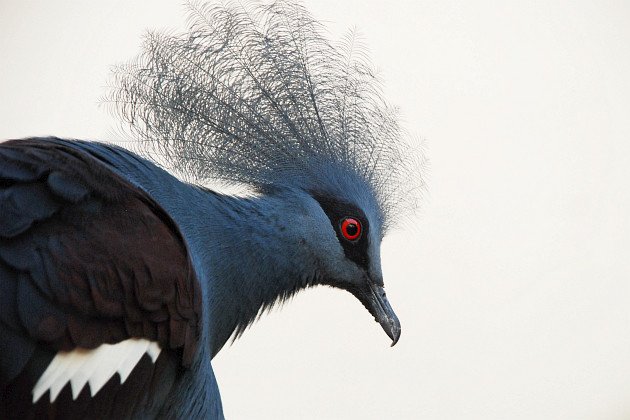
Thankfully not extinct: Western Crowned-Pigeon (Goura cristata) at the National Zoo © David J. Ringer
The Ones Who Didn’t Make It
With specialization comes risk. As members of the raphine tribe spread out and diversified, taking on strange and sometimes flightless forms on small islands, many lost their ability to adapt to new competitors and predators — notably, humans and the animals that travel with us. As the Polynesians and the Europeans started discovering and settling islands, birds that had spent eons adapting to their surroundings started blinking out of existence. These are the lost raphines:
Dodo (Raphus cucullatus)
The Dodo lived on Mauritius, an island east of Madagascar in the Indian Ocean. It gave up flight long, long ago. Despite its relatively recent extinction (in the latter half of the 1600s when the Dutch temporarily settled the island) and its enduring status in popular culture, we know very little about it, not even what it really looked like in life. Here’s a video explanation of how early reconstructions got the bird all wrong, and here are more contemporary reconstructions: a painting by Julian Pender Hume and side-by-side new and old models. I also find this model compelling. For much more, see The history of the Dodo Raphus cucullatus and the penguin of Mauritius (PDF).
Rodrigues Solitaire (Pezophaps solitaria)
The Rodrigues Solitaire (Pezophaps solitaria) was the Dodo’s closest relative. It lived on the neighboring island of Rodrigues and lasted until the mid-18th century but, as another large, flightless bird on a small island, also succumbed to humans. Darren Naish has a great post about how male solitaires, which were much larger than females, had bony clubs on their wings that they apparently used in combat with each other, a behavior he notes, “likely inherited from the [s]olitaire’s volant ancestors.”
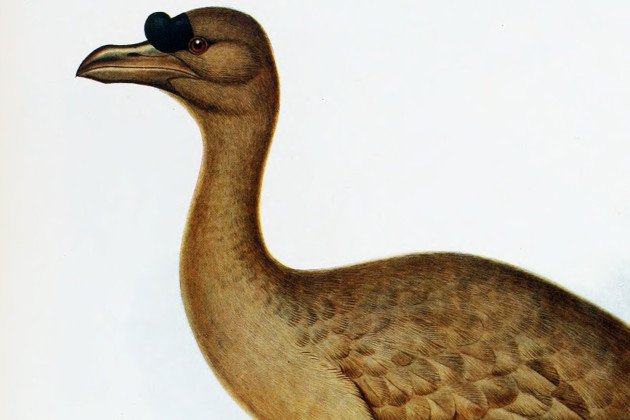
Rodrigues Solitaire (Pezophaps solitaria) reconstruction by Frederick William Frohawk (full image)
Spotted Green Pigeon (Caloenas maculata)
A new paper this year (Heupink et al. 2014) showed through genetic analysis that the mysterious Spotted Green Pigeon (Caloenas maculata), also known as the “Liverpool Pigeon,” was a distinct species closely related to the living Nicobar Pigeon. The bird today is documented physically by only a single specimen (a second was lost), but where the specimens were collected — and therefore where this species actually lived before its extinction — is unknown.
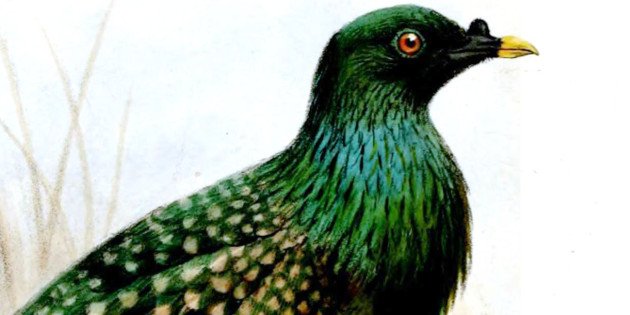
Spotted Green Pigeon (Caloenas maculata) by Joseph Smit (full image)
Kanaka Pigeon (Caloenas canacorum)
A large pigeon similar to the Nicobar Pigeon was described from subfossil bones found in a New Caledonian cave in the 1980s. It was called Kanaka Pigeon (Caloenas canacorum) by the Smithsonian scientists who analyzed the bones (Balouet and Olson 1989). The scientists noted that the species was 25 percent larger than its living cousin and that “it would have been a prime source of food for the early human inhabitants of New Caledonia.” It was flight capable; “there is no indication of reduction in flight capability,” the authors noted, but the species did not survive contact with the first island settlers in eastern Melanesia.
Choiseul Pigeon (Microgoura meeki)
The large, crested Choiseul Pigeon (Microgoura meeki) inhabited Choiseul and perhaps nearby islands in the Solomon Islands. Solomon Islanders say that the species was driven to extinction by cats and dogs introduced by Europeans. Specimens were collected in 1904, and the bird has not been recorded with certainty since. In this video Solomon Islands naturalist Myknee Sirikolo examines five specimens housed at the American Museum of Natural History in New York and — speaking in a mix of Pijin and English — tells other Solomon Islanders about the bird and makes a plea for conservation of the plant and animal species in their forests, other lands, and ocean so that future extinctions can be avoided.
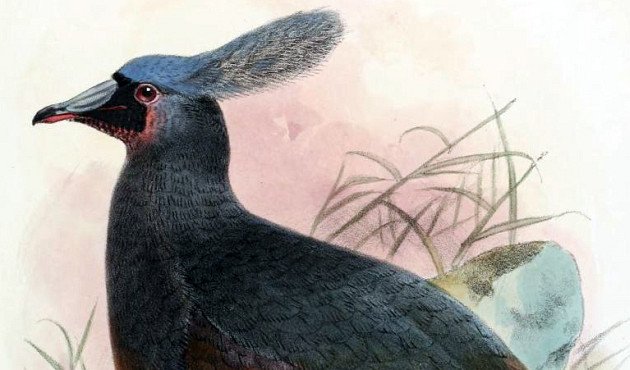
Choiseul Pigeon (Microgoura meeki) by J.G. Keulemans
Viti Levu Giant Pigeon (Natunaornis gigoura)
In 2001, Trevor Worthy described a set of bones from Fiji as a new species of very large, flightless pigeon: the Viti Levu Giant Pigeon (Natunaornis gigoura). The bird’s skeleton bears similarities to New Guinea’s much smaller (!) crowned-pigeons and is thought to have been a close relative. The previously linked Tetrapod Zoology post about wing clubs also contains a couple of speculative reconstructions of this species. Its discovery “shows that flightless pigeons were not confined to the Indian Ocean,” note Hume and Walters in the fantastic book Extinct Birds.
Tongan Tooth-billed Pigeon (Didunculus placopedetes)
A large, extinct relative of the (barely) extant Tooth-billed Pigeon described above was described in 2006 from remains found in Tonga (Steadman 2006). The author notes in the abstract, “As with so many other landbirds in Polynesia, the extinction of D. placopedetes occurred since the arrival of people and presumably was due to human impact.”
Henderson Archaic Pigeon (Bountyphaps obsoleta)
The Henderson Archaic Pigeon (Bountyphaps obsoleta) is another recent discovery, this one discovered in the 1990s and described in 2008 (Worthy and Wragg 2008) from remains found on Henderson Island, which is roughly halfway between Australia and South America. The bones are fragmentary but suggest a placement in Raphini for this large and apparently partially flighted bird that was driven to extinction when the island was temporarily settled by Polynesians 600-900 years ago.
So Here We Are
There is something at once awesome and terrible about the shroud of uncertainty, of distance, that extinction draws across human consciousness. As we squint back through the brief moments of time that have passed since humans began exploring the oceans, groping to interpret a few old bones or some brushstrokes on aging paper, we are confronted with the finality of extinction, the finality of not being able to share our own existence with the Dodo or the solitaire or their kin. They’re separated from us, and it’s we who plunged them into oblivion.
Don’t get me wrong — the strides we’re making in understanding what they were and how they lived are remarkable, laudatory, fascinating, but it’s a different kind of knowing. There were undoubtedly other raphines on small islands. We’ll find the remains of some, and we’ll never know about others that disappeared without a trace.
If there’s a melancholy to this, it’s as it should be, I believe. Unlike an asteroid or a volcano or a species without our powers of cognition, we have the capacity to understand the consequences of our actions for ourselves and for other species. That’s a hard-fought gain, and we’ve made so many mistakes in the course of the struggle. But here we are today. So what now?
…
Extinction is forever. A species, wiped off the earth, never to exist again. What a horror! What a disaster! What a wrong!
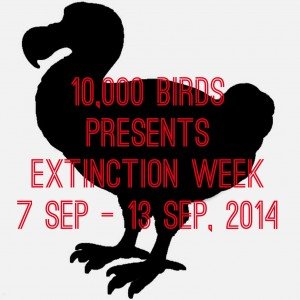 It is correct, of course, to think of extinction this way during the Holocene Extinction, which we are living through right now. After all, the extinctions have occurred, are occurring, and will occur because of us, people. We have so altered the earth – pumping pollution, moving species around, destroying ecosystems – that many species, dependent upon ecological niches or simply unprepared for an onslaught of unfamiliar organisms with which they did not evolve, have no chance. It is depressing and angering and just wrong.
It is correct, of course, to think of extinction this way during the Holocene Extinction, which we are living through right now. After all, the extinctions have occurred, are occurring, and will occur because of us, people. We have so altered the earth – pumping pollution, moving species around, destroying ecosystems – that many species, dependent upon ecological niches or simply unprepared for an onslaught of unfamiliar organisms with which they did not evolve, have no chance. It is depressing and angering and just wrong.
But, in the wider view of things, extinction is necessary. It is what drives evolution. Extinction is what befalls the species that fails to adapt, to survive, to thrive. Most species go extinct. That is just the hard, cold reality of nature, red in tooth and claw.
This is not to say that we should sit back and let the Holocene Extinction continue. No! We must fight to save every species we can, every ecosystem, every niche.
It is the 100th anniversary of the extinction of the Passenger Pigeon, once one of the most abundant species in the world. In order to raise our awareness, to remind us of what we have lost, and to inspire us to fight for Every. Single. Species. we are hosting Extinction Week here on 10,000 Birds from 7 September to 13 September. Come back, click through, read, learn. And get angry and take action.
…













Excellent post on a challenging subject. We humans have really done a number on remote island birds, haven’t we?
Hush…. Question nothing